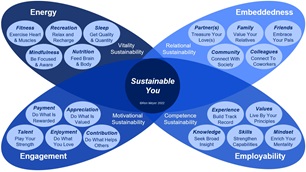Sustainable You Model
How can I keep up my ability to perform throughout my working life? Ron Meyer presents an insightful tool to kickstart your thinking: Sustainable You model.
Key Definitions
Something is sustainable if you can keep it up in the long run. In recent years, it has become commonplace to question the sustainability of our economic value-adding activities, as natural resources are being rapidly run down, while the ecological and social environment are being negatively impacted more quickly than they can recover. But you can also run yourself down, choosing to achieve quick wins in the short run at the expense of your capacity to function and thrive over the long run. Where someone undermines their ability to keep up their level of performance over an extended period of time, we say they damage their personal sustainability.
Conceptual Model
The Sustainable You Model gives an overview of the four key areas in your personal environment in which you need to invest to remain in the game in the long run. With a wink to Muhammad Ali, these four “wings” of sustainability will allow you “to float like a butterfly, but sting like a bee”. Just as the UN has set 17 Sustainable Development Goals for the broader world community, this model presents 20 personal sustainable development goals for you as an individual.

Download picture
Key Elements
The four key areas of personal sustainability are the following:
1. Energy: Vitality Sustainability. To keep functioning in the long run, you first need to maintain your physical and mental energy. You need to safeguard your vigor and avoid running down your battery by paying attention to the five levers of sustained vitality:
a. Fitness. Exercising regularly to strengthen your body and mind.
b. Recreation. Taking time to rest, unwind, refresh, and recover.
c. Sleep. Getting enough high-quality sleep at the right moments in the day.
d. Nutrition. Eating a healthy, moderate, and balanced diet.
e. Mindfulness. Being mentally present, calm, and open to new stimuli.
2. Embeddedness: Relational Sustainability. Your healthy functioning also depends on maintaining the web of relationships in which you are embedded. As a social animal, you can’t thrive in isolation, but need to have warm interactions with five groups:
a. Partner(s). One or more close companions, to have an intimate relationship.
b. Family. Children, parents and relatives, to share time, love, and a sense of belonging.
c. Friends. Best pals and good acquaintances, to talk, laugh and occasionally cry together.
d. Colleagues. Direct and indirect co-workers, to team up with to achieve results.
e. Community. Neighbors and other community members, to live together enjoyably.
3. Employability: Competence Sustainability. To keep functioning in an everchanging work environment, while ensuring that future career opportunities remain, you need to continuously upgrade your competencies. There are five levers of sustained employability:
a. Knowledge. Keeping your information, understanding and insights up to date.
b. Skills. Adding new capabilities to your repertoire of potential behaviors.
c. Mindset. Adapting your attitude and broadening your ways of thinking.
d. Values. Becoming clearer which principles you stand for and live by.
e. Experience. Building a track record and a reputation in specific areas.
4. Engagement: Motivation Sustainability. To keep functioning in the long run, you also need to remain inspired. Some activities will give a quick thrill in the short run, but to stay engaged you need to focus attention on all five levers of sustained motivation:
a. Talent. Engage in activities that fit your natural strengths and avoid your weaknesses.
b. Enjoyment. Seek activities that you love to do and never feel like a chore.
c. Contribution. Find activities that are important to others and will help them out.
d. Appreciation. Select activities that are valued by others and will be welcomed.
e. Payment. Chose activities that are rewarded, both in terms of fame and fortune.
Key Insights
• Sustainability is about not running something down. Something is sustainable if it you can keep it up over a longer period of time. When most people speak of “sustainability”, they mean ecological and social sustainability. This can be called ‘macro-sustainability’.
• Personal sustainability is about not running yourself down. Sustainability is also relevant at the personal, or micro, level. Here the question is whether you can keep up your ability to function over a longer period of time, or whether you are overexploiting yourself.
• Personal sustainability is required in four areas. Each individual needs to avoid overexploiting themselves by maintain four areas: their energy (vitality sustainability), their embeddedness (relational sustainability), their employability (competence sustainability) and their engagement (motivational sustainability). All four areas are equally relevant.
• Personal sustainability is hard in practice. The need to maintain all four areas is easy to understand, yet hard to achieve. Short-term gain, leading to long-term pain, remains tempting. Investing in personal sustainability only pays back in the long run.
• Personal sustainability requires personal SDGs. To strengthen your resolve to invest, it can be useful to copy the UN approach and set personal sustainable development goals that can be monitored and followed up. The Sustainable You Model can be the basis.
Inspired by this kickstart?
The six-day Masterclass Personal Leadership will teach you how to lead people by establishing a connection. You will learn how to identify the underlying motives of others and how to use this knowledge to shape your leadership. At the same time, you will gain insight into your own motives, leadership styles, strengths and weaknesses.
Read more »
Followership Cycle is part 37 of a series of management models by prof. dr. Ron Meyer. Ron is managing director of the Center for Strategy & Leadership and publishes regularly on Center for Strategy & Leadership.